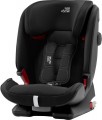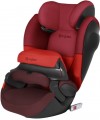Installation
—
Seat belt. Installation with the car seat belt. In weight groups 0, 0+ and 1, only the seat is secured in this way; the child's safety is ensured by the seat's own belts. In weight groups 2 and 3, the car belt is used to secure both the seat and the child.
—
Tor Tether. An additional harness to increase the security of fixation used in seats with Isofix and Latch systems (see below). One end of the harness is attached to the upper part of the backrest and the other end is attached to a special bracket installed in the floor of the car behind the seat or in the trunk. This reduces the likelihood of the seat being knocked over in a sudden braking or frontal impact and increases the overall safety of the small passenger.
—
Support leg. An additional attachment in the form of a support running from the bottom of the seat to the floor of the car. The purpose is similar to the Top Tether described above: it increases the safety of the seat and reduces the risk of the seat toppling when the car comes to a sudden stop. It is most often used with the Isofix system.
—
ISOFIX. The installation system for car seats in the weight category up to 18 kg is primarily found in cars from European manufacturers. The seat is secured with two locks in the rear lower part, with optional additional attachments at the top and/or b
...ottom. The design ensures foolproof installation, making it nearly impossible to install the seat incorrectly. Isofix requires the car to be equipped with suitable brackets, but even without them, these seats can usually be securely installed using the regular seat belt. However, this option may not be cost-effective, as seats with the Isofix system tend to be relatively expensive.
— LATCH. Installation system similar to Isofix. It is used mainly in American cars and, accordingly, in car seats of American manufacturers. The seat is attached at three points — two at the bottom of the seat and one at the top — so that the seat cannot be installed incorrectly. Like Isofix, seats with Latch also allow fixation with the normal car seat belt.Adjustments
—
Backrest tilt adjustment. The backrest tilt can be adjusted. This point is different for various weight groups. In groups 0+ and 1 not the backrest, but the whole seat tilts against the fixed base, and in groups 2 and 2/3 only the backrest tilts. The possibility of adjusting the backrest tilt is important if the child is in the car for a long time – by tilting the backrest you can let the child sleep or rest.
—
Headrest height adjustment. According to safety requirements, the child's head should not be more than one third above the headrest, so it is necessary to adjust the headrest as the child grows.
—
Harness height adjustment. The ability to adjust the height of car seat harnesses — such a need arises as the child grows.
—
Backrest width adjustment. The ability to adjust the width of the backrest allows you to optimally adjust the car seat not only for constantly changing height, but also for the child's complexion.
—
Horizontal position of a backrest. The backrest of the car seat is horizontal. The horizontal position is optimal for babies under the age of six months, since it avoids unnecessary stress on the spine, therefore group 0 car seats usually have this function.
—
Removable backrest. It is possible to comp
...letely remove the backrest of the car seat. This function expands the possibilities of the seat: it can be used both for its intended purpose, with a backrest, and as a booster (for more information on boosters, refer to "Weight group 3").
— Swivel system. The seat swivels relative to a fixed base. This makes it easier to drop off and pick up the child: during these operations, the seat can be turned to face the car door, and when driving, it can be positioned in or against the direction of travel.Harness type
The type of harnesses installed in the car seat. The most popular models are
5-point, which can cover absolutely any age category.
3-points are more common in models for newborns. And the
bumper is not at all connected with the belts, but it also reliably protects the kid. At the same time, there are also 2-point and 6-point (exclusive rare options for the carrycot) and
car seats without belts. More details about each of them:
— 2-point. A harness that covers the child's body around the waist. A rather specific option, found in two types — baby carrycots (refer to "Weight group") and boosters, in which the main fixation is provided by the vehicle's seat belt.
— 3-point. Three harnesses (two across the shoulders, one between the child's legs) that converge in a buckle located near the abdomen.
— 5-point. In addition to the shoulder and crotch harnesses (as in 3-point), they have two additional harnesses at the waist. Such a system is more expensive, but more reliable than a 3-point system.
— 6-point. A distinct format, positioned as a safer alternative to 5-point harnesses, involves harnesses crossing over the shoulders, attaching to special stops on the chair, wrapping around the hips, and securing in a clasp between the child's legs. This configuration aims to minimize the risk of abdominal and ge
...nital injuries during a collision by keeping the clasp in the seat. However, due to the increased complexity of setup and use compared to 5-point harnesses, this design is less common.
— Bumper. The bumper, distinct from a harness, is a specialized rigid device covered with soft material for the child's comfort. It securely encases the child's torso, from chest to crotch, leaving the head, arms, and legs free without requiring additional harness straps. This design offers the advantage of distributing impact load evenly across a wide surface area in the event of an accident, unlike narrow harnesses. Some models even feature the bumper as a usable game table. However, drawbacks include weak upper torso fixation and potential discomfort for the child in warm weather.
— None. The complete absence of own harnesses in the design of the car seat. This feature is found in models of older age categories, where it is supposed to fasten the child with a standard car seat harness.Material
—
Polyester. Polyester is a synthetic fabric made from polyester fibers. The car seats with polyester upholstery have a pleasant to the touch surface. The material itself is not hygroscopic and is not subject to bacterial contamination. It is sufficiently resistant to mechanical stress and does not fade in the sun.
—
Microfiber. Microfiber is made from polyamides. The main feature of microfiber is the unique structure of the fabric. This material consists of numerous micropores, which explains the good ventilation of microfiber. Microfiber-based coverings have a pleasant tactile sensation. The material belongs to the category of well ventilated and breathable. Despite its synthetic origin, microfiber absorbs moisture well, but is easy to wash and dries quickly.
— Alcantara. The car seat with alcantara has an attractive appearance and excellent performance. Alcantara is an artificial suede leather, it is a very durable and practical material. It is easy to clean, does not absorb moisture and does not require any special maintenance. Alcantara is made from a mix of polyester and polyurethane fibers, as a result of complex chemical processing. It is considered one of the most prestigious materials.
—
Eco-leather. Car seats with eco-leather coverings are characterized by high practicality, reliability and durability. This material has hi
...gh wear resistance and is absolutely hypoallergenic. An important difference between eco-leather and genuine one is the thickness of the material — eco-leather is noticeably thicker, but thanks to this it has higher and strength characteristics. However, it is impossible to distinguish a good expensive eco-leather from a natural one at a glance.
— Leather. Genuine leather upholstery is characteristic of premium car seats for kids. This material looks prestigious and solid, while possessing the highest durability and wear resistance. The natural origin of the leather excludes the appearance of the child any allergic reactions to the seat. Also genuine leather is valued for the fineness of dressing, provided that the material retains high durability characteristics. In addition, it is able to absorb moisture.
— Suede. The suede covering will make your child feel comfortable and cozy. Like genuine leather, suede has good durability. This material has waterproof properties and does not require any special maintenance. Suede is obtained by chemical processing of genuine leather with subsequent tanning.
